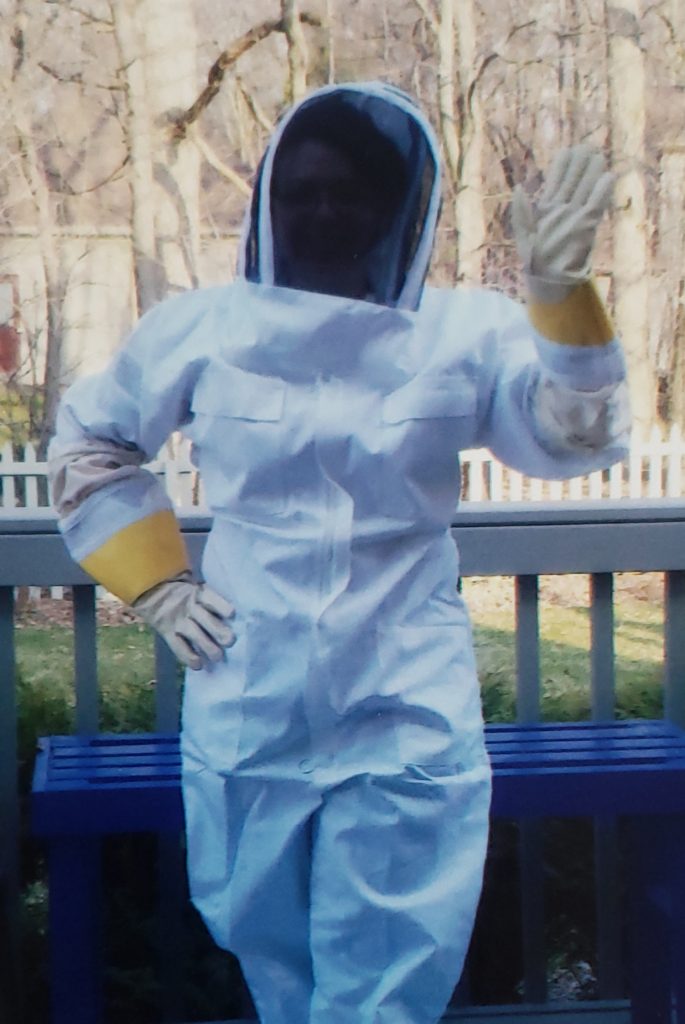Do you know what to look for when buying honey? I’m going to share with you my 3 Best Tips for Buying Local Honey.
Did you know honey can taste different depending on the time of year it was harvested? In this post, I’ll share with you my tips for buying local honey.
Spring 2016: Yep, that’s me standing there barefoot (although you can’t tell from the picture) in my brand-new bee suit. Before we go any further, I need to dispel any misunderstandings up front. I never tended bees barefoot. That really would have been something. No, I wore thick rubber rain boots and sheep-skin gloves past my elbows. Under my suit, I wore heavy jeans with socks overlapping my pant legs, loose long-sleeve shirts and a baseball cap to keep the netting of the hood as far from my face as possible. I was and remain, completely averse to being stung. I’ll never be like those hardcore bee keepers who tend their hives barehanded and unveiled. Please don’t judge me.
Table of Contents
How I got into beekeeping
How did I get into beekeeping? It was a typical blah Michigan winter weekend when I stumbled upon an article in the local paper. The Center of Michigan Beekeepers (COMB) was hosting a seminar on beekeeping. I thought it sounded like a fun way to spend a snowy Saturday. For some time I had been following news stories about colony collapse and other threats to pollinators. I’ve always tried to maintain a pollinator-friendly approach to gardening in my backyard, and this seemed like an interesting way to learn more.
Four months later, I’m driving home from AWS Bees in Swartz Creek, MI with a trunk full of bees. I had purchased two starter packages. All the way home I wondered WTH I’d just gotten myself into.
I approached a few friends at the time about hosting a hive on their property and surprisingly, they agreed. I live in a nice little subdivision and even though I was okay with having thousands of bees tucked away in my back yard, the neighbors were a little more nervous about the prospect. Understandable.
Taking a break
In 2017, I lost my hives during an exceptionally cold winter and decided to take a break from beekeeping for a while. The husband and I are newly empty-nesters, and we’re trying to figure out what our next steps are in life. Do we stay in our current home? Should we downsize and go for something in a walkable, vibrant downtown Michigan city? Or, do we finally buy that 40 acres in the country we’d always talked about and try our hand at living off the grid?
Ideally, a little place in the country would allow me to have hives on our property. This would allow me to walk out the back door at any hour of the day to tend to “the girls.”
What I loved most about tending bees
There’s nothing more satisfying than prying off the lid to a hive to see what the bees have been up to. The air surrounding a hive smells sweet and floral. The white noise from their buzzing is surprisingly calming. And when you hold a handful of bees, the vibration from their wings is absolutely thrilling. I loved each hive’s personality even. Yes, each hive has its own distinct personality.
They are truly amazing creatures and I consider myself so blessed to have been able to experience it first-hand.
You don’t have to be a beekeeper to enjoy the health benefits of honey. And typically, you need only look so far as your local farmers market or health food store. I’m going to let you in on a little secret. I’m going to share with you my 3 Best Tips for Buying Local Honey.
3 Best Tips for buying local honey
You may be thinking, “I really don’t like the taste of honey.” When I had hives, I would often gift honey to people. They’d come back to me afterwards and say they had never tasted honey like mine before. They often said that it tasted like something – not just sweet syrup.
What they had known before was what they had grabbed off the shelf at their local grocery, but that’s not a complete representation of what honey can be. If you REALLY want to experience honey at its finest, you need only follow a few basic rules. My 3 Best Tips for Buying Local Honey: buy local, buy raw, and ask when the honey was pulled.
Tip 1: Buy local
The first of my 3 Best Tips for Buying Local Honey is to simply buy local. Nothing compares to honey that is harvested from the pollen-producing plants in your area. I used to have three hives within a 5 mile radius of each other and they all tasted uniquely different. The flowers the bees gather pollen from truly influence the taste of the honey.
For example, one hive was located near a cluster of apple trees. This hive produced the lightest, most fruit-flavored honey of all my hives. Another hive was located near a clover field and although just as light, its flavor profile was very different from the first – with more floral notes. The third hive was located near a cluster of pine trees. Here’s where it gets interesting. The honey was darker – like a light molasses with a deep, complex and tangy flavor.
We used to have a lot of fun putting together a cheese board and doing a honey-sampling party much like you would do with a wine tasting. I’d encourage you to go to your local farmers market and buy a few jars of honey from different vendors and do a tasting yourself. I think you’ll be pleasantly surprised by the subtle differences a few miles between hives can make.
If you’re interested in reading more about how different honeys and other sweeteners can significantly alter the overall flavor of a dish, check out my recipe post for Appalachian Cranachan. In this post, I map out the historical significance of this traditional Scottish dessert and its use of honey.
Tip 2: Buy raw
The second of my 3 Best Tips for Buying Local Honey is to only purchase raw, local honey whenever possible. When you purchase honey from your local beekeeper, be sure to ask how they process their honey. You want honey that is labeled “raw” or minimally processed – not pasteurized.
Raw honey contains pollen from the surrounding area, and many people who eat raw, local honey (including me) swear that their seasonal allergies are lessened by consuming locally-harvested, raw honey on a regular basis.
Bees will maintain a hive temperature of approximately 95 degrees F. at all times. When you pasteurize or over-filter honey, you are losing all the natural, healthful properties of the honey, so be sure to buy only raw, minimally-processed local honey.
Tip 3: Ask when the honey was pulled
Number three of my 3 Best Tips for Buying Local Honey is to find out when the honey was pulled. Was it a spring harvest? A winter harvest, or perhaps a blend from multiple seasons? When the honey is pulled will also dramatically impact the flavor. Honey that is pulled early in the season (July or August) is characteristically light and delicate. This is often referred to as the first pull and some people feel it is the prime crop.
Honey that is harvested late in the season (September or October) tends to be darker in color and has a more tangy, deep flavor. This is known as the second pull.
At different times of the year, the bees are pulling from different flowers. In the fall, bees gather pollen from sunflowers, golden rod and other late-season flowers. In the spring, the bees are pulling from delicate, early blooms.
Many bee keepers do a blend to achieve a more consistent and balanced flavor. However, I think it’s worth seeking out honey from the same supplier from both the first and second pull. Honey from a single hive can differ in color and flavor depending on the time of the pull, and that too, is a fun way to do a taste testing.
Bonus Tip: Get to know your local beekeepers
This isn’t one of my original 3 Best Tips for Buying Local Honey, but it’s still worth mentioning. Get to know your local beekeepers. The next time you’re strolling through your local farmers market, stop and visit with a few of the honey producers in your area. Ask how they process their honey and if they have honey from different seasons you can try.
Then find a wine and cheese shop that can help you pair your selections. Gather a few friends for a tasting. Use these 3 Best Tips for Buying Local Honey and you’ll never go wrong. You might just develop a taste for honey or find yourself driving back from a bee supplier with a trunk full of bees. If you do it barefoot, I want pictures.


























